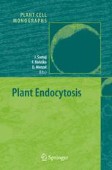Search
Search Results
-
Rab GTPases in Plant Endocytosis
The Rab family is part of the Ras superfamily of small GTPases. In eukaryotes Rab GTPases are present as members of gene families, and the...
-
Why Somatic Plant Cells Start to form Embryos?
Embryogenesis in plants is not restricted to the fertilized egg cell but can be naturally or artificially induced in many different cell types,...
-
Somatic and Zygotic Embryogenesis in Avocado
Avocado is a species widely cultivated for its highly nutritious fruit. Currently, soil-borne diseases such as Phytophthora root rot are severe...
-
Protein Markers for Somatic Embryogenesis
The capacity for somatic embryogenesis is a remarkable property of plant cells. Somatic embryogenesis is the process by which somatic cells...
-
MDR/PGP Auxin Transport Proteins and Endocytic Cycling
Auxin is an essential regulator of plant growth and development. Polarized transport of auxin is responsible for apical dominance, tropic growth,...
-
Somatic Embryogenesis in Genera Medicago: an Overview
This chapter outlines the details of somatic embryogenesis in genera Medicago. Various factors that influence the process of somatic embryo...
-
Somatic Embryogenesis in Rose: Gene Expression and Genetic Transformation
Induction of somatic embryogenesis in roses involves several critical steps requiring specific tissue culture media compositions and particular...
-
Somatic Embryogenesis of Pine Species: From Functional Genomics to Plantation Forestry
Several economically important tree species belong to the genus Pinus and many of them form the ecological base of forest ecosystems. Pine wood is...
-
Cytological, Physiological and Biochemical Aspectsof Somatic Embryo Formation in Flax
The cytological, physiological and some biochemical aspects of somatic embryo formation in flax are discussed. From the review it is obvious that...
-
Chromatin Modifications in DNA Repair
A requirement of nuclear processes that use DNA as a substrate is the manipulation of chromatin in which the DNA is packaged. Chromatin...
-
Quality control of proteins in the mitochondrion
The quality control of proteins within mitochondria is ensured by conserved and ubiquitous ATP-dependent molecular chaperones and proteases, present...
-
The Hsp60 chaperonins from prokaryotes and eukaryotes
The Hsp60 molecular chaperones (the chaperonins) are essential proteins throughout biology. They can be separated into two evolutionary classes: the...
-
Schizosaccharomyces pombe comparative genomics; from sequence to systems
The fission yeast Schizosaccharomyces pombe is becoming increasingly important as a model for the characterization and study of many globally...
-
The Retinoblastoma Gene Family in Cell Cycle Regulation and Suppression of Tumorigenesis
Since its discovery in 1986, as the first tumor suppressor gene, the retinoblastoma gene (Rb) has been extensively studied. Numerous biochemical and...
-
Senescence and Cell Cycle Control
In response to various stresses, such as telomere shortening during continuous proliferation, oxidative stress, DNA damage and aberrant oncogene...
-
Telomeres in fungi
Telomeres are the functional elements concluding and defining each linear chromosome in eukaryotes. They play an essential role in protecting genetic...
-
Systems Biology: necessary developments and trends
At the end of this definition of Systems Biology through exampling, we discuss ambitions, goals, and challenges relating to this new discipline. We...
-
Control of Cell Proliferation and Growth by Myc Proteins
Myc proteins act as signal transducers that alter cell proliferation in dependence on signals from the extracellular environment. In normal cells,...
-
Comparative genomics and gene finding in fungi -- Supplement
Online Supplement to Chapter 1
-
Regulation of the heat shock response by heat shock transcription factors
The heat shock response is characterized by a rapid and robust increase in heat shock proteins upon exposure to protein-damaging stresses. This...
